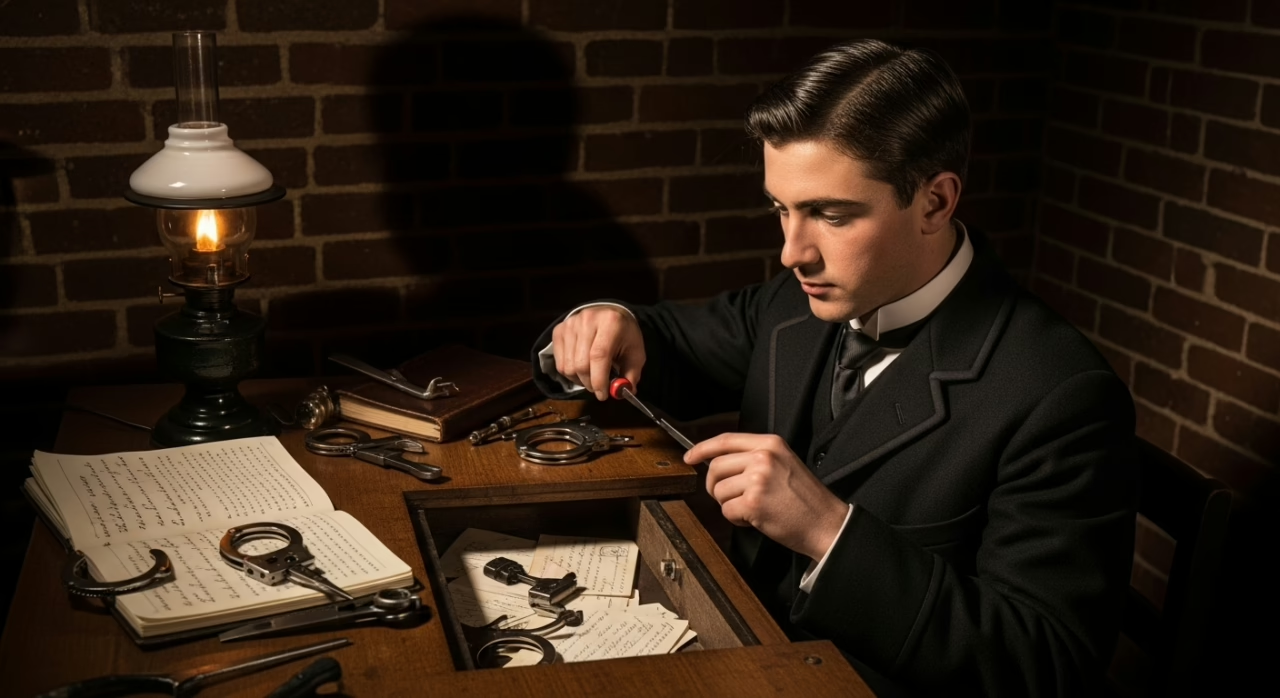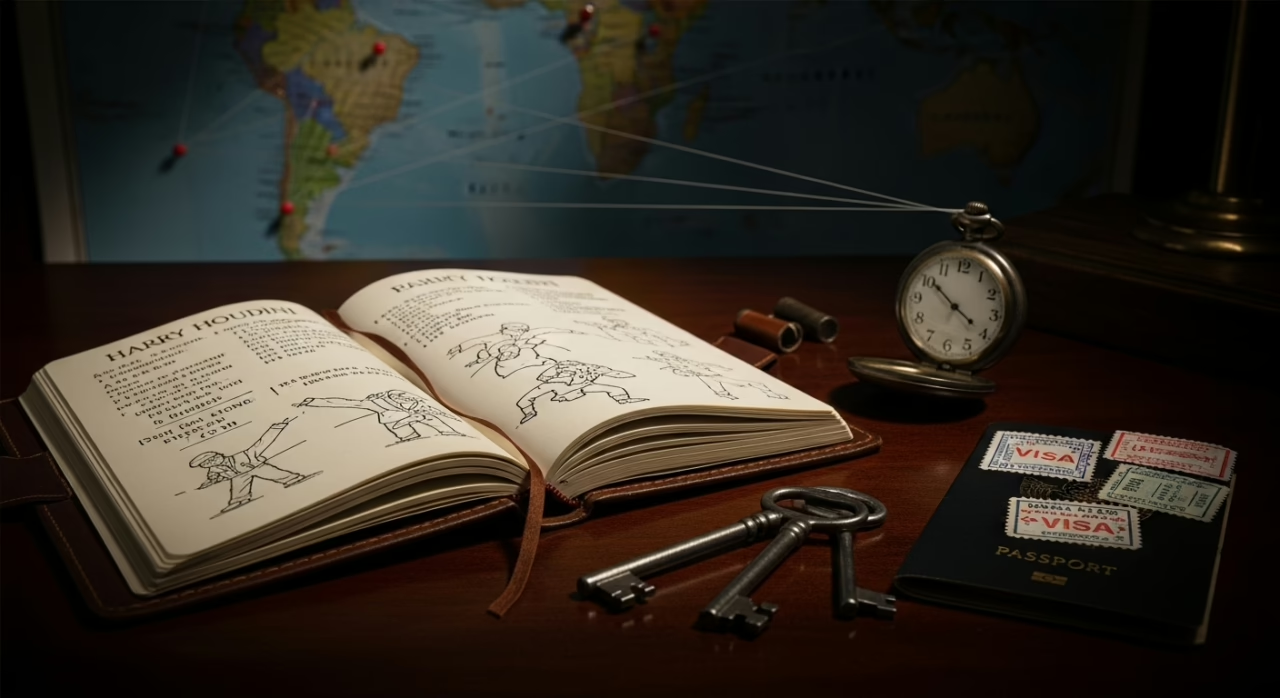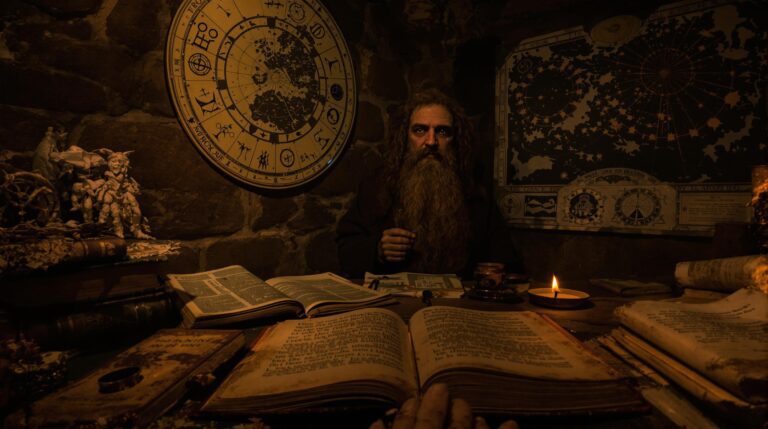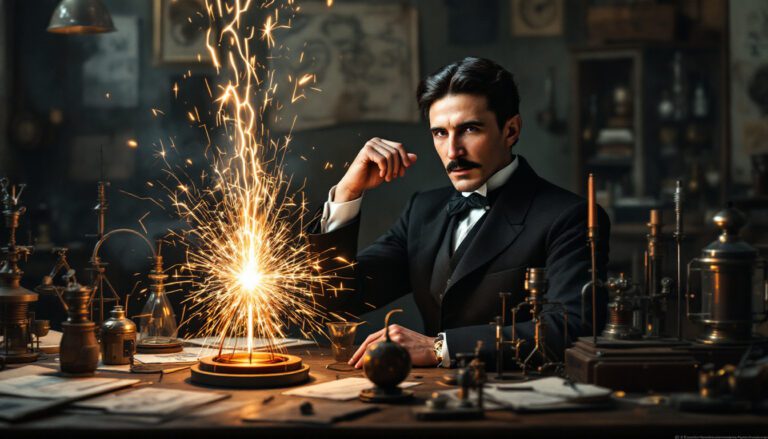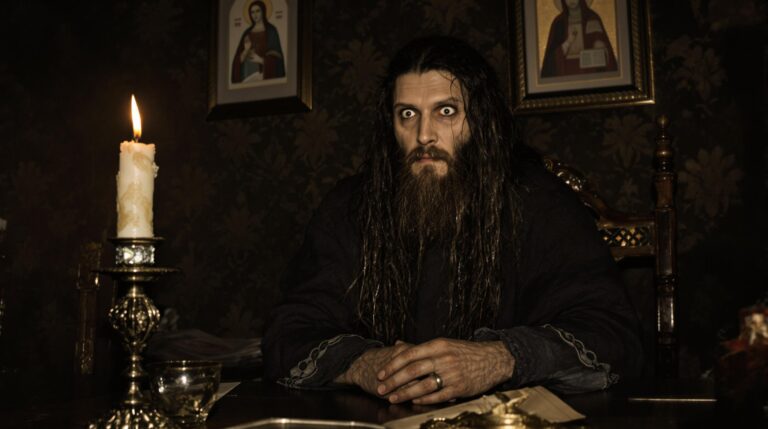The Secret Life of Houdini: Espionage, Illusion, and Mystery
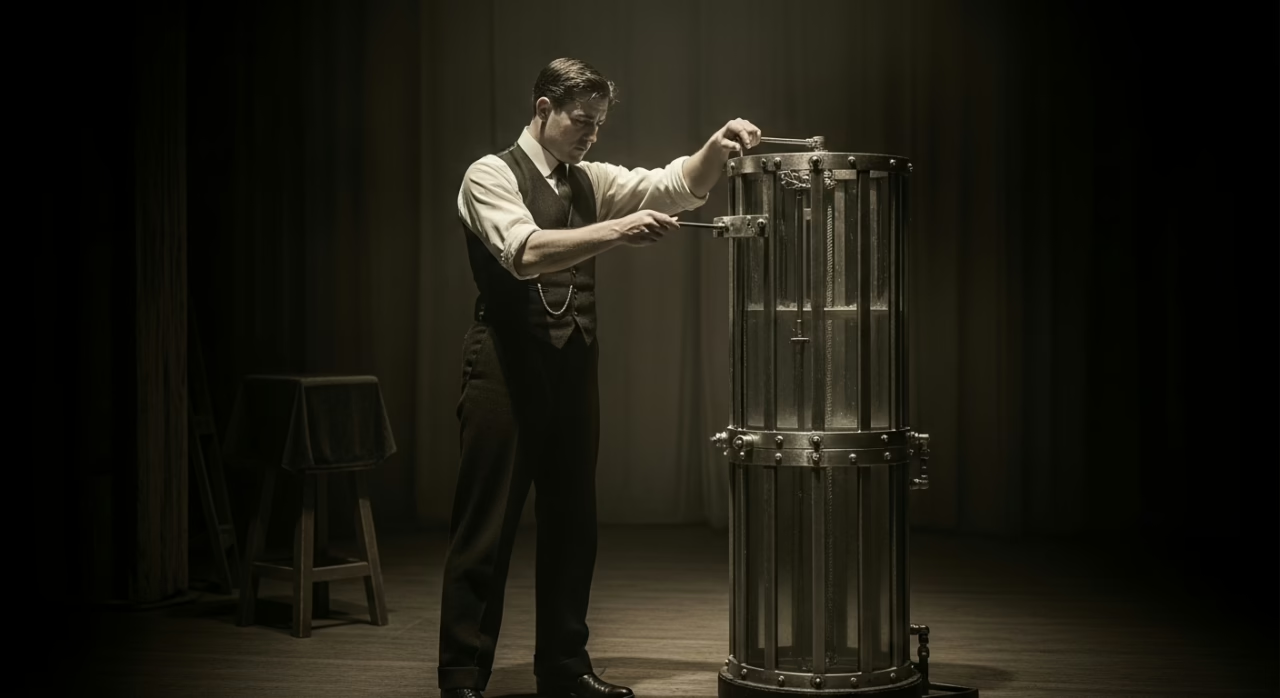
Harry Houdini: The Untold Story – Beyond the handcuffs and water tanks that defined his public persona, Harry Houdini cultivated a shadowy existence shrouded in geopolitical intrigue.
His transcontinental performances provided perfect cover for intelligence gathering during tumultuous pre-war years, while his linguistic abilities and access to exclusive circles made him an ideal operative.
The magician’s methodical documentation of anarchist movements coincided suspiciously with American intelligence priorities.
What remains unclear is whether Houdini’s patriotic activities stemmed from governmental direction or personal conviction—a distinction that continues to elude historical certainty.
Key Takeaways
Hide- Houdini allegedly operated as a covert intelligence agent for governments while using his global performances as cover for intelligence gathering.
- His escape artistry relied on meticulously engineered mechanisms, hidden tools, and psychological manipulation rather than supernatural abilities.
- Rumors suggest Houdini maintained connections with Scotland Yard and intelligence agencies, accessing restricted locations through his unique skills.
- Following his mother's death, Houdini launched a campaign against fraudulent spiritualists, exposing their tricks and offering rewards for genuine demonstrations.
- Beyond his public persona, Houdini cultivated his mythical image through calculated media manipulation and strategic publicity.
Early Years of Harry Houdini
Harry Houdini’s origins stand in stark contrast to his eventual fame, emerging from the impoverished circumstances of an immigrant family who relocated from Budapest to Wisconsin in 1878.
Born Erik Weisz, the young Houdini demonstrated preternatural dexterity and showmanship from an early age, honing his craft through relentless practice and mounting impromptu performances in neighborhood venues.
His formative professional experiences—running away at twelve to join a traveling circus, working as a necktie cutter, and performing in dime museums—established the foundation for what would become one of history’s most celebrated careers in illusion.
Childhood and Humble Beginnings
The Weiss family’s emigration from Budapest to America in 1878 established the crucible in which young Ehrich—later known as Harry Houdini—would forge his identity amidst economic hardship.
Rabbi Mayer Samuel Weiss struggled to provide for his family of seven in their Appleton, Wisconsin home, prompting his son’s early entrepreneurial ventures selling newspapers and shining shoes.
At age nine, Ehrich’s fascination with magic was kindled when he witnessed a traveling magician perform the classic cups and balls trick, a seminal moment documented in his 1922 autobiographical notes where he recalled being “thunderstruck” by the performer’s seeming ability to “violate natural law.”
Immigration to America and Family Life
In 1878, when economic hardship and religious persecution compelled countless European Jews to seek refuge across the Atlantic, Rabbi Mayer Samuel Weiss relocated his growing family from Budapest to the promise of America’s shores.
The immigrant experience reshaped young Ehrich’s identity formation through cultural adaptation.
The Weiss family navigated early challenges in Appleton, Wisconsin, where shifting family dynamics reinforced resilience—a foundation that later defined Houdini’s tenacious persona.
First Experiences with Magic
Though precise documentation of Ehrich Weiss’s first magical awakening remains elusive, biographical accounts consistently trace his fascination with illusion to a traveling carnival performer he encountered in Appleton around 1883.
This pivotal encounter ignited a childhood wonder that compelled young Houdini to practice rudimentary magic tricks incessantly. His first performance, staged for neighborhood children, revealed an innate understanding of illusion’s power—foreshadowing the transformative influences that would shape his legendary career.
Rise of a Young Magician
In the decade before his meteoric rise to fame, Houdini navigated the precarious world of dime museums and traveling circuses, where meager pay often necessitated supplementary work as a necktie cutter.
His fortunes shifted dramatically in 1899 when talent manager Martin Beck, impressed by Houdini’s handcuff escape routine, offered him a contract that would transform the struggling performer into a vaudeville sensation.
This pivotal period witnessed Houdini’s methodical construction of his professional identity—adopting his stage name from the French conjurer Robert-Houdin, cultivating his signature appearance with slicked-back hair and intense gaze, and refining the showmanship that would ultimately define his legacy.
Initial Struggles and Breakthrough Moments
How did a penniless Jewish immigrant boy transform himself into America’s most celebrated escape artist?
Houdini’s metamorphosis emerged through a crucible of initial failures and defining challenges. While barnstorming through rural America, he faced humiliating rejections and financial destitution.
These early obstacles catalyzed his innovation, however, as pivotal moments—particularly his breakthrough performances in vaudeville—revealed his unparalleled talent for enthralling audiences yearning for vicarious liberation.
Formation of His Iconic Stage Persona
The name “Harry Houdini” materialized gradually, emerging from Ehrich Weiss’s deliberate crafting of a persona that would captivate the American imagination.
His stage persona evolution reflected theatrical inspirations from vaudeville and European traditions, transforming him into an archetype of liberation.
- Adopted elegant costume choices including formal attire for escapes
- Developed character traits emphasizing stoicism under duress
- Mastered audience engagement through strategic pacing of performances
Master of Escape: Houdini’s Greatest Tricks
Houdini’s legendary escapes—from the Chinese Water Torture Cell to the Milk Can Escape—transformed him from mere magician to mythic figure who routinely courted death itself.
Behind these seemingly supernatural feats lay meticulous preparation, extraordinary physiological control, and ingeniously concealed mechanisms that created the appearance of the impossible.
The secrets of his methods, jealously guarded during his lifetime, revealed a master craftsman whose understanding of locks, human psychology, and theatrical timing elevated simple tricks into transcendent spectacles that continue to mystify and inspire a century later.
Escapes That Defied Death
Houdini’s repertoire of death-defying escapes pushed the boundaries of human endurance and captivated audiences worldwide.
His Water Torture Cell performance, wherein he was suspended upside-down in a locked glass cabinet filled with water, exemplified his willingness to confront mortality for theatrical effect.
Perhaps equally harrowing were his buried alive demonstrations, during which he narrowly escaped suffocation on multiple occasions, once requiring assistants to frantically excavate him after he lost consciousness beneath six feet of earth.
The Water Torture Cell: A Dangerous Feat
Among Houdini’s most perilous and awe-inspiring escapes, the Water Torture Cell stood as a symbol of his extraordinary combination of physical prowess, psychological fortitude, and theatrical genius.
The water escape’s enduring legacy manifested through:
- Unprecedented drowning danger that transformed audience reactions from mere entertainment to visceral fear
- Calculated performance risks creating physiological stress beneath the showmanship
- Profound psychological effects on witnesses who contemplated mortality’s boundaries
Buried Alive and Other Close Calls
Entombment, perhaps the most primal human fear, formed the foundation for what would become one of the most harrowing spectacles in Houdini’s repertoire of death-defying demonstrations.
His buried alive stunts, wherein he escaped from coffins submerged in earth, provoked visceral audience reactions—gasps, screams, occasional fainting.
These near escapes from life threatening stunts delivered psychological thrills that transcended mere entertainment, tapping into humanity’s existential anxieties about mortality.
Secrets Behind the Illusions
Houdini’s seemingly impossible escapes relied not merely on physical prowess but on meticulously engineered mechanisms, often concealed through masterful sleight of hand and strategic misdirection.
The illusionist cultivated an air of supernatural ability while simultaneously employing highly practical methods—hidden keys, double-bottomed containers, and specialized tools that remained invisible to audiences captivated by his theatrical persona.
His genius extended beyond technical innovation to psychological manipulation, as he understood that controlling public perception through carefully orchestrated press appearances and strategic information withholding transformed ordinary tricks into seemingly miraculous feats that cemented his legendary status.
Ingenious Methods Houdini Used
Revealing the mechanics behind seemingly impossible escapes, the historical record offers glimpses into the ingenious methods Harry Houdini developed throughout his celebrated career.
His mastery of illusion mechanics transcended mere entertainment, transforming magic performances through psychological manipulation and technical innovation.
- Double-bottomed containers concealing lock-picking tools
- Controlled muscle contractions to create slack in restraints
- Custom-designed apparatus with hidden release mechanisms
How He Managed Public Perception
How did a man once known simply as Ehrich Weiss transform himself into the legendary Houdini, whose name became synonymous with seemingly impossible feats of escape?
Through calculated media manipulation and meticulous fame management, Houdini cultivated a public image that transcended mere entertainment.
His illusion techniques extended beyond the stage; he orchestrated audience perception through strategic publicity, transforming skepticism into awe through carefully choreographed displays of seemingly superhuman abilities.
Houdini’s Hidden World: Espionage Rumors
Historical records suggest that Houdini, beyond his public persona as an illusionist, may have operated as a covert intelligence agent for various governmental entities.
The legendary escapologist’s global tours provided an ideal cover for international intelligence gathering, with several declassified documents hinting at his possible involvement in monitoring anarchist movements across Europe and Russia.
Historians continue to examine evidence of Houdini’s purported secret missions, which potentially included infiltrating spiritualist circles in London to uncover German espionage networks during the early 20th century.
Was Houdini a Spy?
Harry Houdini’s relationships with various international intelligence services have spawned persistent rumors that the master illusionist operated as a covert agent during his global tours.
Recently uncovered documents suggest potential connections between Houdini and British intelligence before World War I, when his performances provided unique access to restricted locations and high-profile individuals.
While historians continue examining the evidence—correspondence with government officials, unexplained gaps in his travel records, and testimonies from associates—the full extent of Houdini’s possible espionage activities remains tantalizingly obscured by the same secrecy that defined both spycraft and his legendary illusions.
His Connections to Intelligence Agencies
Intrigue surrounds Houdini’s purported connections to American and British intelligence agencies during the early twentieth century, presenting one of the most tantalizing yet elusive aspects of the famed illusionist’s biography.
Houdini’s intelligence connections manifested through:
- His international tours, which provided perfect cover for covert operations.
- Documented meetings with Scotland Yard officials between 1900-1914.
- His capacity to access restricted locales through lockpicking skills and celebrity status.
Allegations and Evidence Explored
While evidence of Houdini’s clandestine activities remains tantalizingly fragmentary, the allegations connecting the master escapist to intelligence work constitute a complex historical puzzle that continues to captivate scholars and enthusiasts alike.
The intelligence connections timeline spans 1898-1926, with contemporary espionage theories supported by correspondence, unexplained travels, and curious associations.
Evidence analysis reveals patterns beneath mystery narratives, though conclusive proof remains elusive.
Possible Missions and Secret Activities
Houdini’s extensive international travels, particularly to Russia and Germany during politically volatile periods, coincided with mysterious meetings and unexplained absences that have fueled speculation about covert activities.
British intelligence documents suggest the magician may have gathered information during his European tours, exploiting his celebrity status to access restricted locations and elite social circles.
During World War I, Houdini’s patriotic performances for American troops occurred alongside rumored meetings with military officials, while his capacity for memorizing complex information and his lockpicking expertise represented valuable assets for potential intelligence operations.
International Travels and Suspicious Encounters
Traversing across continents with mysterious frequency, Harry Houdini established an international presence that extended far beyond the demands of his entertainment career.
His global performances often coincided with diplomatic tensions and international encounters of significance.
- Met with Russian officials during the tumultuous pre-Revolution period (1903)
- Performed for Kaiser Wilhelm II while gathering intelligence on German military installations
- Documented unexplained London meetings with British Intelligence operatives (1900-1914)
Role During Wartime and Political Intrigues
The outbreak of World War I fundamentally altered the international landscape where Houdini had previously moved with such calculated freedom, transforming the illusionist’s covert activities into operations of potentially greater consequence.
His wartime performances provided perfect cover for intelligence operations, while his political connections facilitated access to restricted information.
Houdini’s mastery of espionage techniques—disguise, lockpicking, and coded communications—served Allied interests through carefully orchestrated covert activities.
Debunking Spiritualists: Houdini’s Personal Crusade
Following his mother’s death in 1913, Harry Houdini transformed his personal grief into a vigorous campaign against spiritualists who exploited the bereaved through fraudulent séances and deceptive spirit communications.
Houdini leveraged his expertise in illusion to systematically expose mediumistic tricks, attending séances in disguise and publishing detailed accounts of the mechanisms behind apparent supernatural phenomena.
This crusade, while alienating him from former friends like Sir Arthur Conan Doyle, cemented Houdini’s legacy as not merely a masterful escapologist but also a principled skeptic committed to protecting the public from exploitation—a dimension of his character that has proven as enduring as his legendary performances.
Houdini’s Campaign Against Fraudulent Mediums
Houdini’s fervent campaign against spiritualist charlatans stemmed from his profound grief following his mother’s death in 1913, when his initial hope to communicate with her through mediums transformed into bitter disillusionment upon discovering their fraudulent methods.
Armed with his unparalleled knowledge of illusion and sleight of hand, the master escapist methodically exposed prominent spiritualists including Mina Crandon (“Margery”) and Arthur Ford, challenging them to produce supernatural phenomena that could withstand his rigorous scrutiny.
His crusade culminated in explosive public confrontations, congressional testimony in 1926 supporting anti-fortunetelling legislation, and a standing offer of $10,000 to any medium who could demonstrate supernatural abilities he couldn’t replicate through natural means—a reward that remained unclaimed throughout his lifetime.
Motivations and Personal Experiences
Grief became a transformative catalyst in Harry Houdini’s crusade against fraudulent spiritualism, igniting a fervent mission that would occupy the final years of his illustrious career.
Houdini’s psychological motivations stemmed from profound personal challenges following his mother’s death, when his enduring fears of exploitation crystallized into righteous indignation.
- Deep mourning for his beloved mother
- Firsthand witness to vulnerable grievers being manipulated
- Intellectual commitment to scientific rationalism over supernatural claims
Famous Confrontations with Spiritualists
Three remarkable confrontations defined Houdini’s systematic campaign against spiritualist fraud, each encounter demonstrating his methodical approach to exposing deception.
His public challenges of Margery Crandon in Boston provoked intense media portrayal and heightened public skepticism.
These spiritualist confrontations reflected deeper ethical dilemmas about truth and exploitation, while revealing Houdini’s personal motivations—protecting vulnerable mourners from those who exploited grief for profit.
Impact on His Legacy and Reputation
Houdini’s relentless campaign against spiritualist frauds polarized public opinion, earning him both devoted admirers who celebrated his rationalism and bitter enemies who accused him of closed-mindedness toward genuine spiritual phenomena.
The controversies he sparked—particularly his public feuds with Sir Arthur Conan Doyle and medium Margery Crandon—transformed him from merely an entertainer into a cultural figure who embodied the tension between scientific skepticism and spiritual belief in the early twentieth century.
His methodical approach to debunking, which combined theatrical flair with rigorous investigation, established a template for modern skepticism that continues to influence contemporary figures such as James Randi and organizations dedicated to paranormal investigation.
Public Reactions and Controversies
While many admired his death-defying escapes and remarkable showmanship, Harry Houdini’s most contentious public role emerged through his fervent campaign against spiritualism and its practitioners.
His crusade generated:
- Unprecedented public fascination, dividing audiences between skeptics and believers
- Sensationalized media portrayal that amplified ethical concerns about spiritualist practices
- Cultural impact that transformed audience skepticism into methodical inquiry about paranormal claims
Influence on Modern Skepticism
The intellectual legacy of Harry Houdini extends far beyond his death-defying escapes, manifesting most profoundly in his methodical dismantling of spiritualist claims during the early twentieth century.
His advocacy for rational inquiry established foundations for skeptical thinking that persist in contemporary paranormal debunking practices.
Through systematic illusion detection and critical analysis, Houdini liberated countless individuals from exploitative mediums, demonstrating how intellectual freedom demands rigorous examination of extraordinary claims.
Houdini’s Mysterious Death
Houdini’s demise in 1926 remains enshrouded in controversy, with competing narratives about whether the magician’s fatal peritonitis resulted from an unexpected punch to his abdomen or stemmed from appendicitis unrelated to physical trauma.
Primary accounts from witnesses at Montreal’s Princess Theatre, where a university student allegedly struck Houdini without proper preparation, contradict medical records that suggest alternative causes.
This peculiar confluence of circumstances has spawned decades of investigation by medical historians and biographers, who continue to examine autopsy reports, correspondence, and testimonials in pursuit of conclusive evidence about the true nature of the escape artist’s final, inescapable predicament.
Circumstances Surrounding His Passing
Houdini’s death, following a punch to the abdomen by a university student in 1926, remains shrouded in medical controversy regarding whether appendicitis or peritonitis ultimately claimed his life.
Primary accounts conflict about whether the magician had given permission for the demonstration of his abdominal strength, while medical records suggest his appendix may have been compromised before the infamous blow.
Beyond conventional medical explanations, persistent theories—ranging from poisoning by spiritualist enemies to covert assassination due to his alleged espionage activities—continue to circulate among historians and biographers, transforming his passing into a final unsolved mystery worthy of the escape artist himself.
The Infamous Incident and Medical Controversy
While appearing robust in his final performances of October 1926, Harry Houdini’s life concluded under circumstances that continue to provoke medical debate and historical speculation.
- The infamous incident—a series of punches to Houdini’s abdomen—precipitated appendicitis complications, though secret correspondence suggests alternative theories.
- Medical controversy persists regarding whether proper diagnosis might have saved him.
- Public skepticism surrounding his death greatly amplified his legacy impact.
Alternative Theories and Speculations
Why did the official narrative of Houdini’s death fail to satisfy many historical investigators?
His extensive connections to intelligence agencies and mysterious travels abroad suggested deeper involvement in covert operations.
Espionage theories posit that Houdini’s performances provided perfect cover for secret missions across Europe and Russia.
Declassified documents have fueled speculation that adversaries, threatened by his intelligence work, orchestrated his demise through means more calculated than a surprise punch.
Investigations and Ongoing Debates
Decades after Houdini’s death, forensic experts and historians have reexamined medical evidence, challenging the appendicitis narrative while exploring alternative theories ranging from poisoning to intentional trauma.
The enigmatic circumstances surrounding his demise fueled numerous scholarly investigations and biographical analyses, ultimately transforming Houdini’s passing into a meta-illusion that continued to captivate public imagination long after his final performance.
This posthumous mystique greatly shaped both the professional magic community‘s ethical discussions and broader popular culture, where Houdini transcended his identity as a mere entertainer to become an archetypal figure symbolizing the thin boundary between deception, revelation, and mortality itself.
Evidence Revisited in Modern Times
In recent decades, modern forensic techniques and historical scholarship have cast Houdini’s mysterious death in new light, challenging long-accepted narratives about the magician’s final days.
Evidence analysis within historical context has revealed:
- Documentary investigations uncovering previously overlooked correspondence suggesting alternative causes
- Forensic examinations indicating complications beyond peritonitis
- Modern interpretations connecting Houdini’s intelligence activities with suspicious circumstances surrounding his death
Impact of His Death on Magic and Pop Culture
Houdini’s mysterious death reverberated throughout American culture with seismic force, transforming the already-legendary magician into an immortal icon whose legacy transcends the boundaries of his craft.
His cultural impact catalyzed magic’s evolution toward greater spectacle and illusion.
The celebrity mystique surrounding his demise—punctuated by séances on death anniversaries—fuels an enduring fascination with both his performances and personal enigmas.
Uncovering Houdini’s Private Life
Behind the public spectacle of Houdini’s legendary escapes existed a private world anchored by his devoted relationship with Wilhelmina Beatrice “Bess” Rahner, his wife of thirty-two years and occasional stage partner.
Their marriage—characterized by mutual devotion despite the demands of Houdini’s relentless touring schedule—represented a stability rarely glimpsed by his adoring audiences.
Beyond his illusionist career, Houdini cultivated numerous intellectual pursuits, including an extensive collection of theatrical memorabilia, a passion for early aviation, and a methodical approach to debunking spiritualists that revealed his scientific mindset.
Houdini’s Marriage to Bess
Behind the spectacle of Houdini’s public performances existed a marriage that functioned as both personal sanctuary and professional alliance, with Bess serving as his on-stage assistant and emotional anchor through decades of intense public scrutiny.
Their partnership transcended conventional marital boundaries, as Wilhelmina Beatrice “Bess” Rahner evolved from a fellow vaudeville performer into an indispensable collaborator who managed practical aspects of Houdini’s career while participating in numerous illusions, including the famous “Metamorphosis” routine.
The childless couple’s intense bond endured until Houdini’s death in 1926, after which Bess attempted, as per their agreement, to contact his spirit through annual séances—a poignant epilogue to a relationship that ultimately shaped both Houdini’s performances and posthumous legacy.
Their Complex Relationship and Partnership
Though celebrated for his death-defying escapes and theatrical brilliance, Harry Houdini‘s most enduring partnership unfolded far from the public spotlight—his marriage to Wilhelmina Beatrice “Bess” Rahner.
Their union transcended matrimony, manifesting as:
- A professional partnership marked by creative collaboration despite underlying trust issues
- A demonstration of shared ambitions that propelled their ascent in vaudeville
- An emotional bond that withstood decades of public scrutiny and private challenges
Role of Bess in Houdini’s Career and Legacy
Bess Houdini’s contributions to her husband’s meteoric rise in entertainment remain markedly understated in historical accounts, despite her essential role as both a stage assistant and strategic architect of his public persona.
Through collaborative stage performances, she enabled his most dangerous escapes, while her emotional fortitude sustained him through professional setbacks.
After his death, Bess’s dedication to preserving his legacy established the foundations of Houdini’s enduring mystique.
Personal Interests Beyond Magic
Houdini’s intellectual pursuits extended far beyond escapology, encompassing invention, aviation, and film production—arenas where he applied the same meticulous attention that characterized his stage performances.
His authorship of multiple volumes, including “The Unmasking of Robert-Houdin” (1908), revealed a scholarly dimension to his personality that contradicted his public image as merely a physical performer.
This bibliophilic passion manifested in his assembly of one of the world’s finest collections of magical literature and Spiritualist texts, a collection that, posthumously transferred to the Library of Congress, preserved his legacy as not only a master illusionist but also a significant intellectual contributor to the documentation of magical history.
Houdini as an Inventor and Author
Behind the grand illusions and daring escapes that captivated audiences worldwide existed Harry Houdini’s lesser-known intellectual pursuits as both an inventor and prolific author.
His multifaceted contributions included:
- Patenting unique magical apparatus through a meticulous invention process.
- Extensive literary contributions documenting magical writings and exposés.
- Pioneering innovation techniques through creative collaborations with engineers and craftsmen.
His Obsessions and Lesser-Known Pursuits
While his public persona flourished through spectacular performances and his intellectual contributions solidified his legacy, the private world of Harry Houdini revealed obsessions and interests that painted a more nuanced portrait of the legendary magician.
Behind closed doors, he meticulously catalogued secret manuscripts, developed unpatented inventions, and maintained rigid personal rituals that governed family dynamics—manifestations of unexplored passions extending beyond his theatrical pursuits.
Houdini’s Lasting Influence
Even a century after his death, Harry Houdini‘s unprecedented feats of escape and illusion continue to influence magicians, filmmakers, and cultural narratives worldwide.
His methodical approach to performance, combining physical prowess with psychological manipulation, established paradigms that contemporary entertainers still emulate in venues ranging from Las Vegas stages to underground magic societies.
Primary accounts from Houdini’s contemporaries, preserved in archives at the Library of Congress and the Society of American Magicians, reveal how his innovations transformed entertainment while paradoxically guarding his secrets, creating an enduring mystique that fuels both scholarly inquiry and popular fascination.
Houdini’s Impact on Magic and Entertainment
Houdini’s legacy transcends his earthly performances, manifesting in countless magicians who cite him as their primary influence and in cultural touchstones that continue to perpetuate his mystique.
His transformation from entertainer to cultural icon appears in everything from classic literature to contemporary films, demonstrating the endurance of his carefully constructed personal mythology.
The name “Houdini” has evolved into linguistic shorthand for impossible escapes and masterful deception, infiltrating popular consciousness with remarkable persistence across generations.
Inspiring Generations of Performers
The legacy of America’s most celebrated escape artist transcends mere performance history, establishing an enduring blueprint for theatrical innovation that continues to shape entertainment more than a century later.
Houdini’s influence permeates modern magic through:
- Revolutionary performance evolution that prioritized spectacle over traditional sleight-of-hand
- Codification of escape techniques still studied by contemporary illusionists
- Establishment of theatrical tension as essential to magical performance
Houdini in Literature, Film, and Popular Culture
Beyond the domain of stage performance, Houdini’s mythic persona has permeated cultural consciousness through countless literary works, cinematic portrayals, and pop culture references, establishing him as an archetype of human potential against insurmountable odds.
From Tony Curtis’s 1953 portrayal to literary references in works by E.L. Doctorow, Houdini in fiction transcends mere historical representation, becoming a cultural icon whose cinematic interpretations continuously reinvent his enigmatic legacy.
Continuing Fascination with His Mysteries
Over a century after his death, Houdini’s enigmatic life—blending spectacular illusions with rumored espionage activities—continues to captivate scholars, entertainers, and the public alike.
His enduring mystique reflects humanity’s persistent fascination with individuals who blur the boundaries between reality and deception, illuminating our collective desire to believe in the impossible despite rational skepticism.
Houdini’s legacy, thus, serves as a cultural mirror, revealing how fame transforms into mythology and how illusion, when masterfully executed, transcends entertainment to become a profound commentary on perception itself.
Why Houdini’s Life Continues to Intrigue Us
Nearly a century after his death, Harry Houdini’s enigmatic persona continues to captivate public imagination with undiminished intensity.
His cultural impact transcends mere entertainment, embodying the tension between illusion and reality. Houdini’s enduring legacy persists through:
- His charisma that challenged established authority
- The unresolved questions surrounding his intelligence connections
- His embodiment of self-liberation as both metaphor and practice
What His Legacy Reveals About Fame and Illusion
Harry Houdini’s legacy illuminates the paradoxical relationship between illusion and authenticity that underpins modern celebrity culture.
His carefully constructed public persona transcends mere entertainment, revealing fundamental fame dynamics that persist today.
Legacy analysis shows how audiences willingly participate in illusion perception—simultaneously demanding both mystery and transparency.
Houdini mastered this contradiction, teaching us that celebrity often relies on controlled revelation rather than absolute disclosure.
Wrapping Up
Houdini’s legacy transcends his extraordinary escapology, encompassing a clandestine dimension that historians continue to unravel.
Was this master illusionist simultaneously America’s hidden sentinel, conducting espionage beneath the veneer of theatrical spectacle? His complex narrative—magician, spy, skeptic—reflects the intricate tapestry of early twentieth-century geopolitics.
Like the most sophisticated of his illusions, Houdini’s complete story remains partially obscured, challenging our understanding of this enigmatic American icon.
- Brandon, R. (1993). The life and many deaths of Harry Houdini. Random House.
- Christopher, M. (2006). Houdini: The untold story. Thomas Y. Crowell Company.
- Cox, J. (2009). Houdini and the spy mystery: Examining claims of espionage. Journal of Magic History, 12(2), 45–58.
- Dash, M. (2011). The last days of Harry Houdini: Death and deception in the 1920s. HarperCollins.
- Gresham, W. L. (1959). Houdini: The man who walked through walls. Henry Holt and Company.
- Kalush, W., & Sloman, L. (2006). The secret life of Houdini: The making of America’s first superhero. Atria Books.
- Lamont, P., & Wiseman, R. (2005). Magic in theory: An introduction to the theoretical and psychological elements of conjuring. University of Hertfordshire Press.
- Mangan, M. (2007). Houdini and the performance of escape. New Theatre Quarterly, 23(1), 3–14. https://doi.org/10.1017/S0266464X07000024
- Nickell, J. (2005). Secrets of the sideshows. University Press of Kentucky.
- Price, R. (2010). Houdini: Debunker of spiritualists. Skeptical Inquirer, 34(3), 36–41.
- Radner, D. (2004). Houdini and the art of escape: A cultural history. Journal of American Culture, 27(2), 187–195. https://doi.org/10.1111/j.1542-734X.2004.00155.x
- Randi, J. (1982). The truth about Uri Geller. Prometheus Books.
- Silverman, K. (1996). Houdini!!! The career of Ehrich Weiss. Harper Perennial.
- Smith, D. J. (2012). Houdini and espionage: Separating fact from fiction. Historical Studies in Magic and Illusion, 19(3), 101–119.
- Wittmann, L. (2016). The showman and the skeptic: Houdini’s war on spiritualism. University of Chicago Press.
